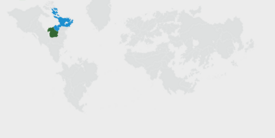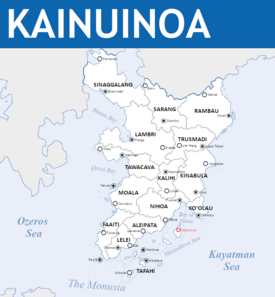Kainuinoa
Council of Kainuinoa ʻAha o Kainuinoa 11 official names
| |||||||||||||||||||
|---|---|---|---|---|---|---|---|---|---|---|---|---|---|---|---|---|---|---|---|
|
Flag | |||||||||||||||||||
| Motto: ᨙ ᨊᨕᨗᨗ ᨓᨕᨒᨙ ᨊᨚ ᨚᨘᨀᨚᨘ᨞ ᨗ ᨀᨘᨘ ᨄᨚᨊᨚ ᨕᨚᨒᨙ ᨄᨕᨘ᨟ E naʻi wale nō ʻoukou, i kuʻu pono ʻaʻole pau "Prevail with my righteous deeds, for they are not yet finished." | |||||||||||||||||||
| Anthem: ᨖᨙ ᨆᨙᨒᨙ ᨒᨕᨖᨘᨗ ᨄᨚᨊᨚ He Mele Lāhui Pono "Song of the Righteous People" | |||||||||||||||||||
 Location of Kainuinoa on Earth. | |||||||||||||||||||
 Political Map of Kainuinoa | |||||||||||||||||||
| Capital | Wahiuliuli | ||||||||||||||||||
| Largest city | Johol | ||||||||||||||||||
| Official languages | Tokohanareo | ||||||||||||||||||
| Recognised regional languages | |||||||||||||||||||
| Ethnic groups (2020) | List of ethnicities | ||||||||||||||||||
| Religion | List of religions
| ||||||||||||||||||
| Demonym(s) | Kainuinoan Kainuinoans (plural) | ||||||||||||||||||
| Government | Federated Theocratic Noocratic Oligarchy | ||||||||||||||||||
• Guide of the Faithful | Kumu Ihupani | ||||||||||||||||||
| Legislature | National Consultative Assembly | ||||||||||||||||||
| Holy Council of the Righteous | |||||||||||||||||||
| Deliberative Council | |||||||||||||||||||
| Unification | |||||||||||||||||||
• Independence from Arthurista | November 13th, 1845 | ||||||||||||||||||
• Formation of the Holy Council | August 8th, 1852 | ||||||||||||||||||
• Safa'atoa Declaration | 1853 | ||||||||||||||||||
• Poi Reforms | April 28th, 1893 | ||||||||||||||||||
| Area | |||||||||||||||||||
• Total area | 134,864 km2 (52,071 sq mi) | ||||||||||||||||||
| Population | |||||||||||||||||||
• 2020 census | 38,000,000 | ||||||||||||||||||
• Density | [convert: invalid number] | ||||||||||||||||||
| GDP (nominal) | 2020 estimate | ||||||||||||||||||
• Total | $674,317,894,800 | ||||||||||||||||||
• Per capita | $15758 | ||||||||||||||||||
| Gini (2020) | low | ||||||||||||||||||
| HDI (2015) | very high | ||||||||||||||||||
| Currency | Kainuinoan Tālā (₮) | ||||||||||||||||||
| Time zone | UTC +6 | ||||||||||||||||||
| Date format | dd/mm/yyyy | ||||||||||||||||||
| Driving side | left | ||||||||||||||||||
| Calling code | +37 | ||||||||||||||||||
| Internet TLD | .kn | ||||||||||||||||||
Kainuinoa officially The Council of Kainuinoa is a Theocratic Noocracy in Southern Ochran between the Ozeros and Kayatman seas. It is bordered to the West by Ankat, to the North by Kiram, and shares a maritime border with Pulau Keramat to the South along the Monusiya strait. The majority of the nation's 38,215,500 people are concentrated on the mainland, while a sizeable portion live on one of the 215 islands and atolls scattered along the bay of Nihoa and southern tip of the mainland. The capital of Kainuinoa is Wahiuliuli, while the largest and most economically important cities are Johol, Faʻaʻā, and Panga. Kainuinoa is characterized by an ethnically diverse population, with Tokotahans groups composing a majority in the South while Lambaneh and Lambri are the largest of the many ethnic groups in the North.
Current archeological evidence suggests that the first archaic human settlers arrived at least 1.83 million years ago, while the earliest remnants of an anatomically modern humans in the region are roughly 40,000 years old. The ancestors of the present-day Lambaneh, Lambrinese, Halaeki, and Urangbuah entered in multiple waves in prehistorical and early historical times. The first kingdoms would rise during the Twin Dragons Period, in which the Lambaneh majority Kualambeh Kingdom would rise up in the East spreading North towards modern Kiram, while the Lambaneh/Halaeki majority Hanajala Empire consumed much of the Western coast up to the border of what is now modern Lusoña. A change in dynasty in the Hanajala Empire would transform it into what would become the regionally predominant Meuihmatan Empire, beginning the Age of Pearls. By 600 CE, the first waves of Tokotahan voyagers would begin to settle on the outer islands and, encouraged by the rising Tahamaja Empire, would begin to spread onto the mainland.
The rise of the Tahamaja would herald the beginning of Tokotahan dominance over the Kainuinoan peninsula and allow cities and settlements they had either founded or taken over to flourish under their rule. The eventual collapse of the Tahamaja Empire would affectively lead to the end of any peace in the region and, by the empires disestablishment in 1460 CE, would have broken into a loose series of alliances of warring city states and chiefdoms engaging in acts of piracy against each other. While a number of minor kingdoms and empires would attempt to vie for control over the peninsula, it was not until the arrival of the Mutulese in the 1600s that modern Kainuinoa would begin to shape into its modern borders. It was under the rule of the Mutulese that Tokotahan chiefs began to work more closely with the rulers of Lambaneh, allowing them to exert political and tapu religious authority further North and West. As the Mutulese global circuit began to crumble, by the 1800s Kainuinoa had solidified into the Royal Kainuinoan Federation encompassing the entirety of its modern borders. A brief period of Arthuristan dominionship over a number of ports, including the key trading port of Faʻaʻā and Ha'afeva led to the Revolution of the Righteous, leading to the removal of the Chiefs as the ruling class of the country, replacing it with the council of religious scholars that rules the nation up to the modern age.
Etymology
Demonyms
Official title
Geography
Climate
Biodiversity
History
Prehistory & antiquity
-early settlement -Twin Dragons Period
Age of Empires
-Meuihmatan Empire -Tokotahan Migrations -Tahamaja/Age of Pearls
Age of Humiliation
-Age of Fire -City States -Mutulese Global Circuit -Arthuristan Period
Manaʻolana ā paulele
-Assertion of Tokotahan cultural hegemony -Revolution of the Righteous -Hanaki War -Lambrinese seperatism
Modern history
-Strait conflicts with Pulau -Ozeros Community lore
Government & Politics
Law
Foreign Relations
Military
Constituencies
Economy
Agriculture
Energy
Tourism
Transportation
Science and Technology
Demographics
Ethnic Groups
Languages
Religions
Education
Health
Culture
Architecture
Cinema
Clothing
Cuisine
Holidays
Literature
Sport
Cite error: <ref> tags exist for a group named "lower-alpha", but no corresponding <references group="lower-alpha"/> tag was found
